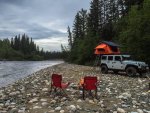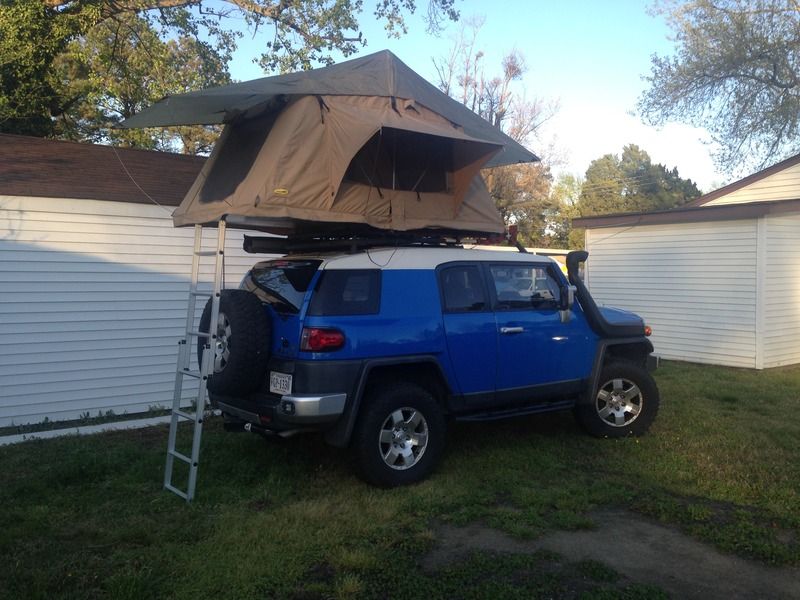mountainkatt
New member
I am not affiliated with Tepui, nor was I granted access to this tent for the reason of review. My husband and I have been researching different brands and styles of RTTs for a little over a year. When a local shop brought a few options in, we finally threw all that research into the wind and pulled the trigger on a Tepui Ruggedized Kukunam. We have the anti-condensation mat under the 2.5” foam mattress. The tent got a trial by fire as we left a short 4 days later for an 8,600km overland trip through varying climates and elevations. We spent a night in the snow in Canada outside of Lake Louise, a week in the high desert in Utah, and ‘slept’ through a 96 km/h windstorm at the Grand Canyon to name a few. It was set up in the dark, in the daylight, in the rain, in -15 degrees celcius, in the wind and on the ground.
Set-up and usage:
Getting the TRK on the roof rack of our jeep proved to be a simple process. The tracking rails were already attached to the bottom as it was set up in the store. We simply had three men lift it onto the roof rack and aligned the bolts. Eight nylock nuts later, it was secured. Three men were required as our roof rack on a lifted jeep already sat at seven feet tall.
Once home, we set the tent up with our sleeping gear inside to save space in our jeep. Our sleeping system consists of two sleeping bags, two fleecy blankets, two thin bag liners and two pillows. I folded each of these in half so they sat just short of the ‘bend’ of the tent floor. With the sleeping gear inside the tent, it was a little harder to close up, but not impossible. Some days, if I didn’t fold everything just flat enough, it required me hanging off of it to tighten the side retaining straps.
The thing about the ladder:
Read the instructions carefully. Seriously. It’s not that hard but it’s a really great way for your tent to feel floaty and to pinch toes in the spare steps if you don’t set it up right. The ladder must be extended all the way first. I put the bottom down and then go under the tent and start collapsing the spare steps from the TOP step down. Usually I just need to do two but it will depend on the height of your vehicle.
The thing with the elastic straps:
I couldn’t find mine at first. Once I did… hallelujah. The four elastic straps with clip ends are attached to opposite walls before you close it. It certainly helps to pull the tent fabric in. So don’t misplace those.
The weather:
In the snow, we left the windows toggled closed and only unzipped a small section of each window. There was a great deal of condensation on the walls in the morning, but it dried out quite well and there was none present under the mattress. Twice we set up and slept up in wind in excess of 95 km/h. My husband slept fine. I felt like I was sleeping in a boat. This is in part due to our vehicle being quite off-road capable (read, soft suspension). The rain fly snapped around a bit in the wind, but the bendy poles held up with no struggle. The fabric of the tent shed snow and rain with zero effort.
A note to the short:
I hope your vehicle is closer to the ground that mine. I currently stand on the tires, door frames, window frames, and even right up on the roof rack to sit on the tent if I have to close it by myself. It’s not impossible, but I have tumbled from the jeep at least once. My tire carrier must be open for me to get close enough to the back of the vehicle to pull the ladder down, but it’s not the end of the world for me to stand on the hitch. Conversationally, if you have a tall vehicle like a lifted jeep, having specific fender flares (like the Metalcloak ones I lust after) that you can stand right on (and boy can you!) would make getting it up and down much easier.
Pros:
At 5’ 3” I was still able to set up the tent on my own (but I do use my jeep as a jungle gym to accomplish this)
Quick set-up (sub 3 minutes)
Most comfortable camping experience in a long time
Condensation dries out quickly
Easy to take off the roof in needed
Seams are sealed well, no gaps
Zippers are sturdy
Cons:
Didn’t see the elastic straps to pulls the tent fabric in until half way through the trip. It would have made folding in down a lot easier from the beginning.
It’s hard to zip the stiff rubberized cover in -15 celcius because it freezes pretty solid.
Collapsing the ladder for storage on top the tent is difficult if you’re not seven feet tall
Summary:
I would recommend this tent (and it’s price point) to those looking to use a quick set up, soft sided RTT. It’s roomy, comfortable and stands up in weather at varying climates and altitudes. I look forward to seeing how it holds up over the year and a summer of hard use.
Set-up and usage:
Getting the TRK on the roof rack of our jeep proved to be a simple process. The tracking rails were already attached to the bottom as it was set up in the store. We simply had three men lift it onto the roof rack and aligned the bolts. Eight nylock nuts later, it was secured. Three men were required as our roof rack on a lifted jeep already sat at seven feet tall.
Once home, we set the tent up with our sleeping gear inside to save space in our jeep. Our sleeping system consists of two sleeping bags, two fleecy blankets, two thin bag liners and two pillows. I folded each of these in half so they sat just short of the ‘bend’ of the tent floor. With the sleeping gear inside the tent, it was a little harder to close up, but not impossible. Some days, if I didn’t fold everything just flat enough, it required me hanging off of it to tighten the side retaining straps.
The thing about the ladder:
Read the instructions carefully. Seriously. It’s not that hard but it’s a really great way for your tent to feel floaty and to pinch toes in the spare steps if you don’t set it up right. The ladder must be extended all the way first. I put the bottom down and then go under the tent and start collapsing the spare steps from the TOP step down. Usually I just need to do two but it will depend on the height of your vehicle.
The thing with the elastic straps:
I couldn’t find mine at first. Once I did… hallelujah. The four elastic straps with clip ends are attached to opposite walls before you close it. It certainly helps to pull the tent fabric in. So don’t misplace those.
The weather:
In the snow, we left the windows toggled closed and only unzipped a small section of each window. There was a great deal of condensation on the walls in the morning, but it dried out quite well and there was none present under the mattress. Twice we set up and slept up in wind in excess of 95 km/h. My husband slept fine. I felt like I was sleeping in a boat. This is in part due to our vehicle being quite off-road capable (read, soft suspension). The rain fly snapped around a bit in the wind, but the bendy poles held up with no struggle. The fabric of the tent shed snow and rain with zero effort.
A note to the short:
I hope your vehicle is closer to the ground that mine. I currently stand on the tires, door frames, window frames, and even right up on the roof rack to sit on the tent if I have to close it by myself. It’s not impossible, but I have tumbled from the jeep at least once. My tire carrier must be open for me to get close enough to the back of the vehicle to pull the ladder down, but it’s not the end of the world for me to stand on the hitch. Conversationally, if you have a tall vehicle like a lifted jeep, having specific fender flares (like the Metalcloak ones I lust after) that you can stand right on (and boy can you!) would make getting it up and down much easier.
Pros:
At 5’ 3” I was still able to set up the tent on my own (but I do use my jeep as a jungle gym to accomplish this)
Quick set-up (sub 3 minutes)
Most comfortable camping experience in a long time
Condensation dries out quickly
Easy to take off the roof in needed
Seams are sealed well, no gaps
Zippers are sturdy
Cons:
Didn’t see the elastic straps to pulls the tent fabric in until half way through the trip. It would have made folding in down a lot easier from the beginning.
It’s hard to zip the stiff rubberized cover in -15 celcius because it freezes pretty solid.
Collapsing the ladder for storage on top the tent is difficult if you’re not seven feet tall
Summary:
I would recommend this tent (and it’s price point) to those looking to use a quick set up, soft sided RTT. It’s roomy, comfortable and stands up in weather at varying climates and altitudes. I look forward to seeing how it holds up over the year and a summer of hard use.




